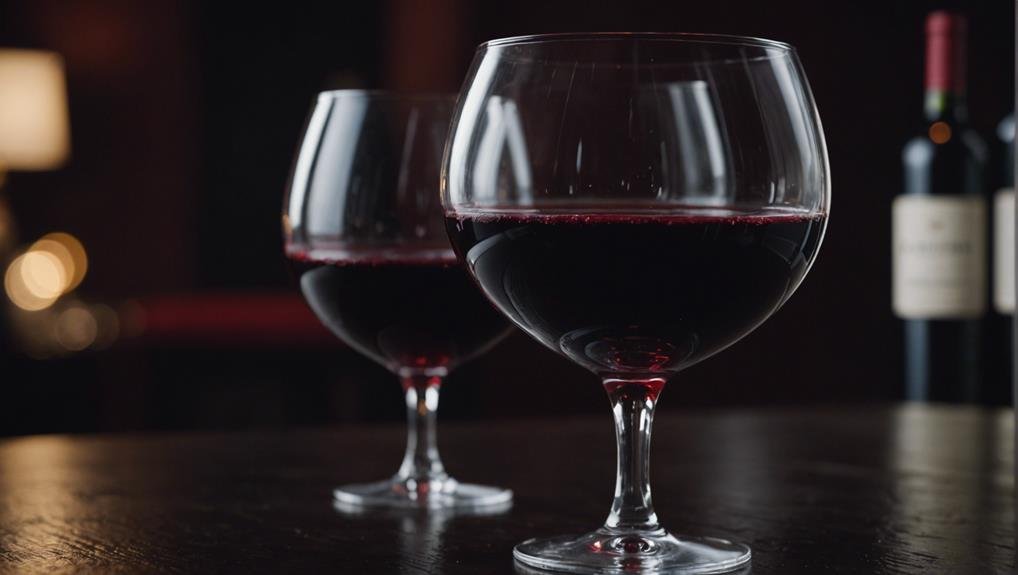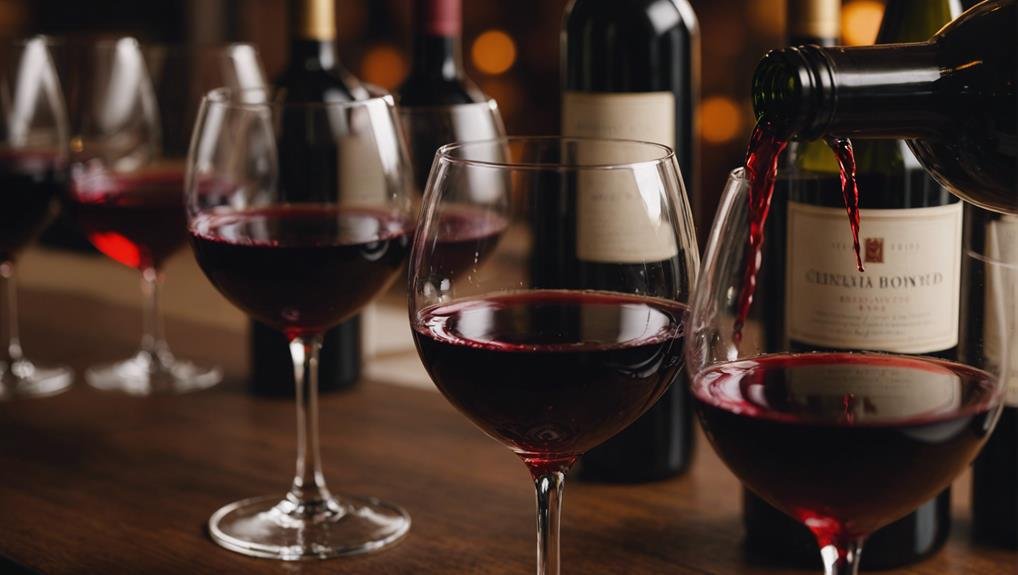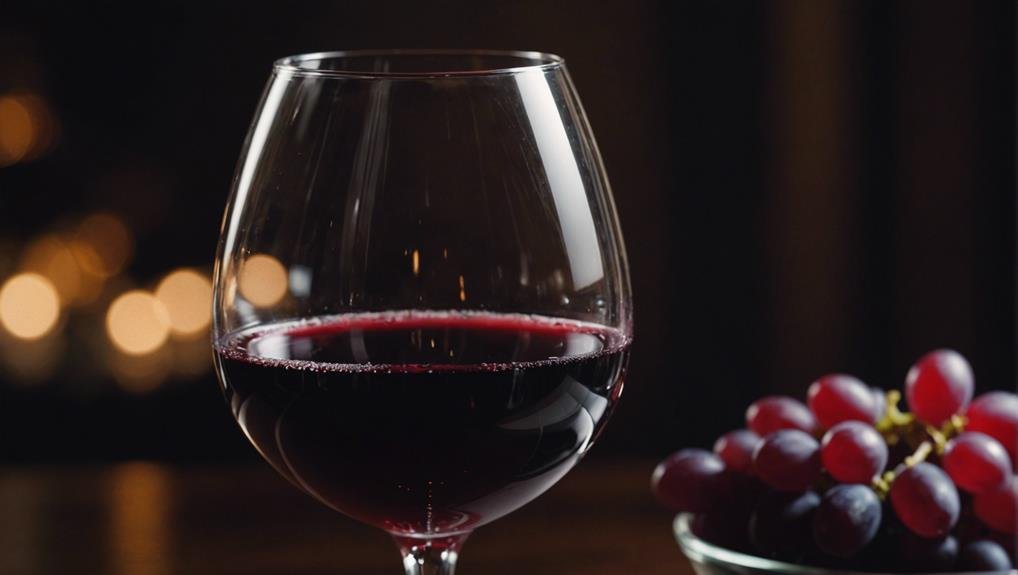When it comes to exploring the world of deep red wines, a fascinating journey awaits those who delve into their rich complexities. From the bold tannins of Petite Sirah to the savory notes of Mourvedre, each grape variety tells a unique story through its deep red color.
By uncovering the meticulous winemaking techniques that shape these robust wines, a tapestry of flavors and textures emerges, tantalizing the taste buds with layers of depth and sophistication.
Join us as we venture through the alluring realm of deep red wines, where every sip reveals a new and exciting discovery, waiting to be savored.
Characteristics of Darkest Full-Bodied Reds

Full-bodied red wines are known for their rich tannins, bold flavors, and deep color profiles that make them stand out in the world of wine. Varieties like Petite Sirah, with its high tannins and blackberry notes, or Mourvedre, famous for its meaty flavors and dark color, offer a unique sensory experience.
Shiraz delights with a sweet tobacco finish, while Syrah surprises with hints of black olives and Red Velvet cake. From Douro Reds' fresh blueberries to Nero D'Avola's blend of licorice, black cherry, and leather, each wine has its own distinct profile.
Whether you prefer Malbec with its blueberry and vanilla notes or Cabernet Sauvignon with peppery, cedar-infused flavors, these full-bodied reds promise a rich and satisfying drinking experience.
Winemaking Techniques for Full-Bodied Reds
Crafting full-bodied red wines is a detailed process that involves a careful combination of winemaking techniques to enhance their richness and complexity.
- Extended Maceration: Keeping the grape skins in contact with the juice for a longer period extracts more color, tannins, and flavors.
- Punch-downs and Pump-overs: These methods help extract compounds from the grape skins, resulting in a more intense and flavorful wine.
- Barrel Fermentation: Fermenting the wine in oak barrels adds depth and texture from the oak's influence.
- Blending: Mixing different grape varieties or batches together creates a balanced and full-bodied wine.
- Extended Aging: Allowing the wine to mature in oak barrels or bottles helps develop its depth and richness over time.
Influence of Alcohol Content on Richness

When crafting full-bodied red wines, the alcohol content plays a crucial role in enhancing the richness and texture of the final product. Higher levels of alcohol contribute to a wine's viscosity, giving it a weightier feel on the palate. Wines with an alcohol by volume (ABV) of 14% or higher often display a more substantial mouthfeel.
Moreover, alcohol content influences the formation of wine tears, which indicate the wine's viscosity and body. Extended oak aging can also intensify alcohol levels in wine. For winemakers striving to create full-bodied reds, careful consideration of alcohol content is vital to achieve the desired richness and depth in the finished product, offering wine enthusiasts a satisfying and complex tasting experience.
Impact of Residual Sugar on Texture
Residual sugar plays a crucial role in influencing the texture of wine, which greatly impacts the overall sensory experience for wine enthusiasts. When residual sugar is present in wine:
- Viscosity increases, changing how the wine feels in the mouth.
- A touch of sugar can enhance the richness of the wine without being overwhelming.
- Winemakers typically aim to limit sugar content to around 3-4 grams per liter.
- Stopping fermentation early can help maintain the desired level of sweetness in the wine.
- The balance between sugar and alcohol levels affects the wine's texture, harmonizing sweetness with the body of the wine.
Understanding and managing residual sugar levels is essential for crafting wines that offer a balanced and enjoyable tasting experience for consumers.
Factors Contributing to Wine Viscosity

Factors that affect the thickness of wine include the grape's seeds, which contribute to tannin levels and overall structure. Winemakers carefully choose yeast strains and fermentation methods to enhance the wine's texture and taste.
Malolactic fermentation is a common technique used to improve the wine's feel. Oak aging also plays a significant role in adding tannins, aroma compounds, and body to the wine.
The alcohol content impacts viscosity, with higher levels giving the wine a heavier feel. Additionally, residual sugar can increase viscosity, but it's important to balance sweetness to avoid overpowering the wine's richness.
Frequently Asked Questions
How Does Oak Aging Impact the Flavor of Full-Bodied Red Wines?
Oak aging plays a significant role in enhancing full-bodied red wines by infusing them with tannins, aroma compounds, and a richer body. This process introduces a range of flavors such as vanilla, cedar, and pepper, adding depth to the wine. Moreover, extended oak aging leads to an increase in alcohol levels, which in turn contributes to the wine's overall richness and weight on the palate.
What Role Does Yeast Play in the Production of Full-Bodied Red Wines?
Yeast plays a crucial role in enhancing the texture and flavor of robust red wines. Winemakers carefully choose specific yeast strains to influence the mouthfeel of the wine. Malolactic Fermentation is used to enrich the wine's complexity and depth. Aging the wine in oak barrels adds tannins and aromatic compounds, further contributing to its overall character. Alcohol levels and residual sugar levels also play a part in shaping the texture of the wine, making it a multi-faceted sensory experience.
Can Residual Sugar Levels Affect the Overall Texture of Red Wines?
The amount of residual sugar in red wines plays a crucial role in determining their texture, much like how a skilled chef carefully balances sugar in a gourmet dish. A touch of sweetness can enhance the richness of the wine, but going overboard can disrupt the overall harmony of flavors. Winemakers pay close attention to this factor to ensure a refined and balanced palate experience for wine enthusiasts.
How Does the Choice of Grapes Influence the Darkness of Red Wines?
The type of grapes used can significantly impact the color intensity of red wines. Grapes with thick skins, high tannins, and deep pigmentation such as Petite Sirah and Mourvedre are known to contribute to the rich color and full-bodied characteristics of the wine, ultimately affecting its overall darkness.
Do Different Fermentation Techniques Affect the Richness of Full-Bodied Red Wines?
Fermentation techniques have a significant impact on the richness of full-bodied red wines. Factors such as the type of yeast used, malolactic fermentation, and the duration of oak aging all play vital roles in shaping the wine's characteristics. These elements affect the wine's texture, levels of tannins, aroma profile, and overall body, contributing to a deeper and more complex flavor profile.
Conclusion
In the realm of rich, full-bodied red wines, each type boasts a distinct and intricate flavor profile crafted with precise winemaking methods.
From luscious blackberry undertones to deep, intense hues, these wines enchant aficionados with their complexity and richness.
Symbolizing refinement and elegance, these robust reds beckon us to delve into their layers of flavors and textures, transforming each sip into a delightful exploration.